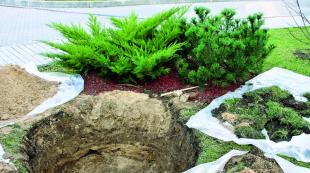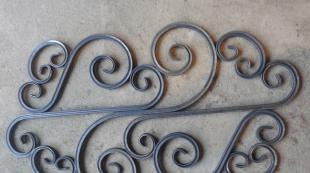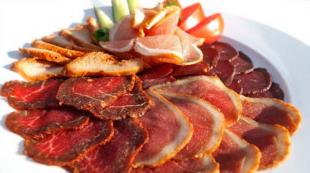What is a do-it-yourself knife sharpener. Knife sharpener - an essential tool in the household About improvements to these bottle cutters
A do-it-yourself knife sharpener is a necessary device for any work in the kitchen or in the workshop. Use is perfect sharp knives greatly facilitates the preparation of food, allowing you to apply less force for butchering meat, slicing vegetables or bread. Working with a blunt knife is not only inconvenient, but also dangerous, because such a tool can break off the material being cut at any time and injure you.

Via homemade sharpener for knives, you can sharpen the knife at any angle, since the sharpening angle is independently adjustable.
In order to bring any knife to a sharp state, you should know the optimal angle of its sharpening. This parameter depends on the grade of steel and the purpose of the knife. Homemade tools will help you set the knife at the right angle in order to sharpen it quickly and efficiently.
How to sharpen knives

Figure 1. Device for sharpening knives "House".
Some types of kitchen knives cannot be sharpened on their own. These include specially shaped tools (for example, a bread knife or other types of knives with a raised edge). Also, you can not sharpen ceramic knives. However, the advantage of these tools is that manufacturers try to make them from especially hard steels, so they do not dull for a long time.
For proper sharpening, you should choose good abrasives of different grain sizes. Shop options for such bars are quite expensive, but you can always make a bar yourself from a piece of wood pasted over with fine sandpaper. It is important to have devices of different grain sizes: large ones for preliminary “peeling”, and small ones for grinding.
The optimal sharpening angle of the knife edge is from 20 to 30 degrees, depending on the functional purpose of the tool. It is quite difficult to manually sharpen at this angle, therefore, simple home-made mechanisms are used for this purpose.
Back to index
Assembling the knife sharpener
Among the whole variety of devices for sharpening knives with your own hands, you should choose the one that will best suit your goals. All devices have a fairly simple structure and consist of two main parts:
- an emphasis for reliable fastening of a knife;
- movable abrasive block.

Figure 2. Wooden case in the form of a right-angled triangle to accommodate a whetstone.
The simplest tool for creating a sharp blade edge is called a "house" (Fig. 1). It has the form of a rectangular or square wooden block, the upper face of which is processed in the form of a gable "roof". The angle of inclination of the faces of such a bar is 20-25°. The knife to be sharpened is set with its edge close to the crest of the “roof”. By moving the abrasive bar in a horizontal plane along the blade, we will ensure that the sharpening angle is maintained at a constant value.
There are also quite complex devices. To create them, you will need some materials, tools and a little time, but you will provide yourself with a convenient tool for sharpening for a long time. The assembly of the device is carried out from the following materials:
- wooden board, dimensions 500x150x20 mm;
- metal studs, 8 mm in diameter with thread;
- several M8 bolts and nuts, wood screws;
- clamping screws of the "lamb" type;
- textolite or a piece of steel for the pressure plate;
- optional neodymium magnet for a secure hold of the knife during the sharpening process.
From wooden board you need to make the body in the form of a right-angled triangle, and the lower leg should be slightly longer, since it will be placed on the rack for the grindstone (Fig. 2). The inclined board is attached at an angle of 20° to the base. A hole is made in it for fastening the pressure plate, through which a screw with a “lamb” clamping nut will pass.

Figure 3. It is necessary to drill a hole for a vertical pin, which will serve as a holder for the abrasive tool.
Near the sharp corner of the structure, it is necessary to drill a hole for a vertical pin, which will serve as a holder for the movable abrasive structure (Fig. 3). A small wooden block is put on the hairpin, which is clamped with a screw with a clamping nut.
The last element of the fixture is another pin with a clamp holder for an abrasive bar (Fig. 4). Clamps can be made independently from wood, metal, ebonite or other material, or you can use a disassembled clamp for this. For better stability, rubber feet can be glued to the bottom of the tool (video 1).
In order to sharpen a knife using such a device, it is placed on a magnet, and in its absence, it is pressed against the stop, holding it with your hand. The angle that occurs between the surface of the knife blade and the horizon provides optimal sharpness for kitchen knives. By making longitudinal movements with the holder with an abrasive bar, you need to achieve a sharp edge of the knife, then turn it over to the other side and repeat the steps.
As abrasive bars, you can use ready-made products that you can purchase at a hardware store or make them yourself. To do this, use small rectangular plates of glass, 4-5 mm thick. With the help of double-sided tape, sandpaper of different grain sizes is glued to their surface. The cost of such bars is very low, and sandpaper can be replaced with a new one at any time. The only caveat is to carefully tighten the clamp nuts, otherwise the glass can easily break.
One of the problems that arise when using such a device is the rapid wear of the abrasive, since water is not used during operation. For the same reason, too fast movements should be avoided, leading to overheating of the metal and loss of cutting edge properties.
Back to index
Common mistakes when sharpening knives by hand

Figure 4. Hairpin with holder-clamp for abrasive bar.
If you do not sharpen knives professionally, but are among the people who use these tools only in everyday life, then before you start sharpening yourself, you should learn about some common mistakes beginners:
- The first and most common mistake is not sharpening the cutting edge. It consists in the fact that when working with abrasives, a lot of small burrs form on the working surface of the knife, which create a feeling of sharpness of the knife. In the first few uses, the burrs fall off and the blade becomes dull again. To prevent this from happening, it is important to sharpen the tool to the end. For a more detailed examination of the cutting edge, you can use a magnifying glass - it will make it possible to control proper conduct process.
- The presence of dirt on the blade. Never sharpen a dirty, greasy knife. Sometimes you can see how professional chefs in the process of cooking take a round file with a handle - musat, pass it several times over the tool and continue to work. But this is not a sharpening accessory, this device is used only to align the edge of the knife.
- It is important that not only dirt is removed, but also residues of previous, larger abrasives, as they easily mix with the fine sanding material, leading to scratches and bumps.
- Too much pressure. The sharpness of a knife does not depend on the force applied to the bar, but on the duration and accuracy of sharpening. Too much pressure will break the cutting edge.
- Wrong choice of sharpening angle. This parameter depends on two indicators: the purpose of the tool and the grade of steel from which it is made. For kitchen knives, the optimal angle is between 20 and 25 degrees. Camping, hunting and fishing knives must withstand heavy loads, while not dulling. For them, the edge angle is up to 40 degrees. For comparison: the sharpness that allows you to use the knife as a razor is 10-15 degrees.
A convenient sharpening machine will be useful to every man in the house. After all, the owner is often judged by how sharp this kitchen tool is.
There are many techniques for sharpening knife blades. For example, for a process carried out at home, only a turning bar or ready-made fixtures with an angular gap shape will be sufficient.
To adjust expensive hunting knives, European manufacturers produce devices in the form of solid bars, which are based on a high-strength alloy.
This article will describe the manufacture of a machine for sharpening knives with your own hands.
Why do knives get dull?
What is the reason why a knife becomes dull when cutting? This can be explained by the fact that abrasive particles that are present in the material being cut have a negative effect on the cutting edge. For example, they are present on vegetables, paper. In simple terms, the blade is subject to gradual wear.
The next reason is the inability to keep the blade in the right position all the time. Any trembling of the hand causes the knife to tilt, which entails a lateral load.
sharpening technique
The sharpening technique consists in unified, but at the same time quite laborious methods. The main task is to eliminate damage to the blade. It should be noted that for many, such a procedure as sharpening knives provides a good mood and calm.
The basic rule in this process is to maintain a precisely set constant angle. Strength is not required here. The main thing is that the bar and the blade meet at a certain angle. This is the basic rule of sharpening technique.
What needs to be done to maintain a constant angle?
In order for the angle to have a constant index, there are two ways. The first is to acquire the skill of sharpening. The angle indicator can be controlled using a conventional marker. They should paint over the carts and after several sharpening cycles, see how much the paint has survived. If it is worn unevenly, then the blade is not well processed.
If the knife being sharpened is decorative, then the blade should be sealed with adhesive tape so that only the edge for cutting remains open. Even if you unsuccessfully direct your hand, there will be no scratches on the blade.
It is also important that the direction of the blade along the bar is perpendicular to the edge at the points of contact. In fact, this is quite difficult to do. It is acceptable for the angle between the edge and the blade to be less than 90 degrees. But when directed along the cutting edge, this indicator is not suitable.
The abrasive particles of the bar can leave grooves on the blade that will never be sharpened, but will play a positive role when cutting. If the grooves are oriented along the cutting edge, then they will not be useful when cutting. The worst thing is that the cutting edge can break off altogether.
It is important that the bar is long. It should be one and a half or two blade lengths. It is acceptable that the diamond bar be somewhat shorter, as it grinds faster and better. Its width does not play a significant role. If it is wider, then it is more convenient to work on it and there is less chance of leading the blade beyond the device. It might hurt him side surface or a blade.
Homemade knife sharpeners come in a variety of designs. All that is required from the manufacturer is the availability the right material and tool skills.

The principle of operation of such a device as a manual machine for sharpening knives with your own hands is to hold the knife blade in a vertical position and drive it along a bar fixed at the right angle. This is much easier than placing the sharpener horizontally and holding the knife at just the right angle.

In order to make a do-it-yourself knife sharpening machine, you need a piece of laminate, a wooden rail, sandpaper and a pair of lamb bots. Chipboard or plywood can serve as a replacement for laminate
To make a knife holder, you need to cut off part of the material. So that the bar does not touch the holder when sharpening, it is necessary to clean its edge at an angle with emery.
Need to mark and cut off the top vertical rack, which will serve as a support for the bar. The angle is chosen two times less than the one with which the knife will be sharpened. For kitchen knives, it is recommended to take an angle of 10-15 degrees.
A do-it-yourself knife sharpening machine, the drawings of which are obviously drawn up, involves the correct calculation of the length of the base of the racks. Please note that the subsequent installation of the transverse support will affect the height indicator. After that, all the details are cut off, and the edges are cleaned.

Holes are marked and drilled in the base and plate for pressing the bolts that fix the blade. When marking, the distance of the holes from the edge of the base is maintained. This is necessary for the versatility of the fixture, since all knives have their own width. The pressure plate is fixed with bolts.
Vertical posts are attached with screws. The moment that the load on the bottom is small is also taken into account. In this case, it is better to resort to using thermal glue. The horizontal bar is attached in exactly the same way. The grinder is almost ready. It remains to make a bar.
For its manufacture, a rail of the desired length is cut. Sandpaper is glued to one edge with the right size abrasive. To optimize the result, you can resort to the manufacture of several bars with different grain sizes. The range P600 - P2000 is considered the best. In order to protect your hands from cuts, you need to screw the handle on the top side of the rail.
As a result, it turns out homemade machine for sharpening knives with your own hands, characterized by high functionality and practicality. During operation, the device rests against the edge of the table, which is quite comfortable when using it.
A do-it-yourself knife sharpening machine can also be of a different type. In this case, it is based on the M8 threaded rod. Two large washers and nuts were used, which serve to hold a bar 200 mm long.

Closes the thread. A pair of paper clips hold the rail stand at the correct height. This ensures smooth adjustment of the sharpening angle. The base is a beam, the thickness of which is 40 mm. It is supported by hand.
How to sharpen planer knives with your own hands
Every owner who has a planer or jointer has probably faced the problem of sharpening their knives. Buying new ones from time to time is expensive. Knives can be easily sharpened by hand. In this case, specialized machines are used, or if it is used constantly, then it would be better to make a machine for sharpening knives with your own hands.
Do-it-yourself planer knife sharpening machine
To sharpen the planer knife, special sharpening equipment is used. The machine for sharpening knives with your own hands has a compact size. It can be installed in the garage or on the plot.
Many are interested in how to make a machine for sharpening knives with their own hands. To make a device, you need to find certain parts. Perhaps these parts are lying around in your shed or garage. They can also be purchased online.
The machine for sharpening planer knives with your own hands consists of:
- faceplates;
- table;
- engine;
- vacuum cleaner;
- casing.
First of all, you should find a faceplate. This is the most important component of future equipment. It is she who is responsible for the sharpening process. Jointer knives are narrow, and the faceplate serves as a guarantor of complete and safe sharpening. This part will have to be bought new, but the rest can be used old.
It is better to purchase faceplates of German or American production. The average cost of a part is 25,000 rubles.
The next step is to find the engine, the power of which should be 1-1.5 kW. It is not necessary to buy it. Any will do, even old ones washing machine. But everyone will surely have a table, a casing and a vacuum cleaner.
The main steps in the manufacture of the device
When the table is selected, the engine is fixed directly below it. A faceplate is attached to the moving part. The engine must initially be equipped with a button that turns the unit on and off. It should be comfortable.
For reliable protection, the faceplate is covered with a square-shaped casing with one cut corner. It is this area that needs to be sharpened.
On the bottom surface of the table in the area of sharpening, a hole is made of the same diameter as that of a vacuum cleaner hose. The presence of a vacuum cleaner is not essential, but it is desirable to install it. It removes unnecessary dirt from blade processing.
What do you need to know?
Mounting the motor under the faceplate base is optional. You can make sure that the parts are connected by means of a belt. In this case, the design will be complex.
A do-it-yourself jointer knife sharpening machine is also suitable for saws and axes.

Ice screw sharpening
The sharp knives of the ice drill enable the fisherman to quickly make holes in the ice of reservoirs. However, over time, all cutting tools become dull and require sharpening.
For fishermen, a quality ice drill is a great pride. Often, true competitions are held on water bodies in terms of the speed of drilling ice holes. And victory does not always smile at young and strong fishermen who are armed with imported devices. There are cases when seasoned fishermen equipped with simple Soviet-made tools are the winners in the competition. The reason for the high hole drilling speed lies in the good sharpening of the knives and the correct setting of the device. Beginner anglers, having bought new Swedish devices, do not even have time to blink an eye as their knives become blunt. The smallest grains of sand and pebbles in the ice contribute to the formation of chips and gouges on the blade.
Sharpening of devices is carried out by the most different ways. Many of our ancestors did not even know what a professional was. In most cases, sharpening was carried out using hand-made devices.
Homemade ice drill machine: what is needed to make it?
For the manufacture of such a device as a knife sharpening machine, you will need two strips of steel, the thickness of which is 4 mm, the width is 60 mm, and the length is 200 mm. A spring from a car is often used as a strip. But she is very hard to bend.

Working process
First you need to make the body of the device. The steel strips are bent in such a way that the chamfers of the knives pressed against the ends of the arc are not only parallel, but also in the same plane.
After making the arc from the same steel strip, the pressure plate is bent, which serves as a lock for the sharpened knives.
Holes for M12 or M14 bolts are drilled in the body and pressure plate. Having pulled the body and pressure plate together with a bolt and nut, we clamp the knives between them and check the strength of their fit to the surface of the end face of the emery circle.
If the knives are not located at the required angle (the chamfers do not fit exactly to the circle), then the device is modified by bending the body arc to the appropriate level. If the knives stand correctly, then the structure is disassembled, and stiffeners are welded to the arc of the body on both sides.
Sharpening of knives is carried out better on which rotates horizontally. In this case, when wetting the knives with water, the latter remains on the blade and stone longer, ensuring their safety. Dip your knives in the water more often. This will help prevent overheating of the steel.
Minus the device
The disadvantages of the device include the impossibility of sharpening knives with different angles of the cutting chamfer. But each manufacturer of ice drills offers its own models. In this case, a universal device will do.
Making a universal fixture for sharpening an ice drill
The universal design allows sharpening knives at any angle of the cutting edge. By smoothly changing the angle between the shoulders of the unit, on which the knives are fastened with screws, it is possible to fix the desired position of the knives in relation to the plane of the grindstone.
To manufacture this device, you need to find a door canopy with minimal play, as well as an M8 or M10 screw with its own nut. Holes are drilled in the shoulders of the canopy. Their diameter is 6-7 mm (for attaching knives to them with screws).
From a steel strip, the thickness of which is 3 mm, a fixing plate with a slot for the fixing screw is made. The plate and screw are welded to the shoulders of the canopy.
It happens that sharpening of knives is carried out, the location of the holes of which does not correspond to the holes in the canopy. In this case, additional holes for knives are drilled in the shoulders. non-standard look. In this case, the device has more versatility.
How are planer knives sharpened?
Attachments such as planers and thicknessers can often be seen in country houses. By means of them, raw lumber is brought to the desired state. Knives of these devices, like any others, become dull. If you use them often, then the best way out is to sharpen the knives for the planer with your own hands. For the manufacture of grinding equipment at home, you will need various materials: metal, aluminum or wood.

The knife holder can be made from a wooden block. Having done through circular saw cuts at 45 degrees, you can sharpen knives with a belt grinder or a large bar. If the latter is not present, then sandpaper is attached to a smooth surface made of metal, wood, chipboard or glass.
Knife holders can be made from improvised materials. The optimal solution will be the use of metal corners that have an indicator of 90 degrees. When placing two knives on the sides, the sharpening angle of each will be equal to 45 degrees. Using screws, you can fix the knives with a second corner.
There are always cutting, sawing and planing tools in the household. In the course of work, the sharpness is lost, and the blades have to be restored. You can give knives - planes to the workshop, but money is spent on this, and extra time is wasted. Therefore, home craftsmen prefer to sharpen the tool.
Important! Only blades with some degree hardening. If the cutting part has a hardness higher than 55 HRC, it cannot be sharpened with improvised tools.
You can buy a tool for sharpening knives or other household utensils in the store. Save time, but spend a lot of money - good sharpening is expensive.
By the way, there are different opinions about the name of the device for sharpening knives. Emery, touchstone, whetstone, whetstone, musat ...
Can these definitions refer to the same object, or different products? About this, and how to make such a device yourself, we will tell in the article.
Since the advent of cutting objects (weapons, knives, axes), people have been looking for a way to restore the sharpness of the edge. In the Bronze and Copper Ages, it was easy.
The simplest variation of sharpening - homemade device from wooden and abrasive bars. To make it, you will need two bars of each type - they must be strictly the same size. Wooden products must first be treated with sandpaper to remove all burrs from their surface.
The manufacturing procedure itself will not cause difficulties. First, mark the wooden blocks: taking into account the required angle of sharpening the knives, draw lines for future attachments of abrasive blanks. Then attach whetstones to the resulting lines and mark their width on the wood. The next step is cuts: according to the marking, make cuts of the required slope and depth of 1-1.5 cm on both wooden products. Insert abrasive bars into the recesses and fix them with bolts.
Advice. So that the resulting device does not slip on the surface during the maintenance of the knives, attach a rubber gasket to it from below - it will give the device the necessary stability.
Massive sharpener on a stand
A more complex variation of the knife sharpener is a stand with a separate support and a sharpening rod attachment. For its manufacture you will need:
- chipboard sheet;
- wood block 8 cm long and 2x4 cm in section;
- steel rod M6 or M8;
- plexiglass 6x12 cm;
- magnet with holes for fasteners;
- self-tapping screws, bolts, wing nuts;
- wooden clamps;
- rubber feet;
- saw and drill.

Sharpener construction scheme:
- Cut three blanks from a chipboard sheet: 7x8 cm, 8x30 cm and 12x37 cm.
- On the oblong side of the workpiece 8x30 cm, stepping back 6 cm from the edge, make a hole.
- In the corners of the workpiece 12x37 cm, drill holes for the legs.
- Drill two through perpendicular holes in a wooden block: the first - 3 cm from the edge, the second - 3 cm from the first. From the edge of the product to the first hole, cut out a recess 1 cm thick.
- Make a cut in the center of the plexiglass strip.
- On a workpiece 12x37 cm, stepping back 4 cm from the edge, fix the workpiece 7x8 cm perpendicularly with two screws. Fix the workpiece 8x30 cm from above with self-tapping screws.
- AT highest point of the installed workpiece 8x30 cm, drill a small recess and fix the magnet in it with self-tapping screws. Put plexiglass on the same workpiece - fasten the products with a bolt through the previously made hole and slot.
- On any edge of the workpiece 12x37 cm, drill a hole for a steel sharpening rod and fix it there with a wing nut.
- Put a bar on the rod, securing it with a bolt and nut.
- From the rod, nuts and two clips, assemble a knife holder.
- Screw the legs to the finished stand.
How to sharpen a knife?
For high-quality, it is still not enough to build one of the above devices - you also need to master the rules of manual sharpening, and figure out the order of work.

First, the required sharpening angle of the tool is calculated - it must be maintained throughout the entire sharpening process. Then, with smooth movements, alternately “away from you” and “towards you”, begin to drive the blade along the grinding element - an abrasive or a rod. In one movement, it should go along the sharpener from edge to edge. In this case, the movements are performed perpendicular to the edge of the blade.
Important! At the end of each pass, the blade should remain on the sharpener, and not fall off it, otherwise you can not only dull the knife even more, but also deform its side surface.
Drive the blade along the sharpener with one side until a barb appears on its back side - then turn the knife over and start sharpening the second side of the blade in the same way. Continue sharpening with alternating sides until the burrs are completely gone. Gradually reduce the pressure of the knife.
How to determine the angle of sharpening?
The most important parameter for sharpening a knife is the required angle of inclination of the blades. It depends on the scope of a particular tool and the range of tasks that are assigned to it:
- Razor of any type - an angle of 10-15 degrees.
- Fillet knife - 15 degrees.
- Knife for fruits, bread and vegetables - 15-20 degrees.
- Multifunctional tools for cutting food - 20-25 degrees.
- Hunting knives - 25 degrees. Such blades are designed for cutting not only soft products, but also wood, bones, and tissues.

- Utility knives for general use - 25-30 degrees.
- Tourist and camping knives - 30-35 degrees.
- Knives for cutting hard materials - 30-50 degrees. The larger the sharpening angle, the worse such a knife cuts food, but the better it copes with wood, trunks, and plastic.
Please note that there are also combined knives: they are divided into several zones with different sharpening angles. The advantage of such tools is versatility, the disadvantage is the complexity of maintenance.
So, assembling a knife sharpener with your own hands is an excellent way out of a situation where there is no desire to buy a professional device or regularly contact the craftsmen for tool maintenance. Here are two options for making sharpeners of different levels of complexity - choose which one is within your power and use it strictly according to the indicated rules, so that sharpening is not only of high quality, but also safe.
DIY knife sharpener: video
Almost every person in life is faced with the question of sharpening knives. After all, any knife, regardless of its quality, sooner or later becomes dull. Therefore, the blade must be carefully looked after.
In stores today you can choose any sharpener among a huge variety.

What are sharpening stones?
In general, there are several main types of such devices. Namely:
Oil, on the surface of which there is oil, especially to save material.

Water, similar to the previous one, but water is used here.

Natural, industrially processed.

Artificial, made from non-natural materials.

Rubber, extremely rare. Completely inconvenient to use.

Nuances in the issue of sharpening
There are moments in sharpening every knife.

For example, Japanese independent type sharpening requires special attention of a rather experienced specialist, since the Japanese look of steel is quite fragile. To sharpen them, manufacturers give a recommendation to use different water stones, endowed with a variety of grain sizes.

Mistresses use sharpeners bought in the store for sharpening. When using several knives, their sharpness lasts longer.

But this is very important, even though it takes a lot of time and effort.

How to sharpen knives properly?
For this it is necessary to create special conditions. Thanks to them, the knife will remain sharp for a very long time.

Therefore, it is important to choose the right angle at which you will sharpen your knives. According to the basic rule in this matter, the smaller the angle at which the knife is sharpened, the stronger the cutting edge will be.

It is important not to forget that the next sharpening depends on the maximum sharpness. The sharper the knife, the faster it will need to be sharpened. At the same time, it will be much more difficult to make it “workable” again.

Why sharpen knives?
The purpose of sharpening is to restore the sharpness of the blade. To do this, take care of the correct sharpening angle. That is, it is necessary to restore the previously set angle that meets the standards from a technological point of view.

To check how well the sharpening is done, cut the material that is cut with the blade of this particular knife. If the material is cut elementarily, you will do everything absolutely right.

Possible problems during the sharpening process
In order to choose the right angle correctly, it is important to have some experience, without which it is quite difficult to cope with this issue. And even more so if there is no special equipment for this.

After all, if you hold the knife with your hands during the sharpening process, it is quite difficult to achieve its ideal “sharpness” as a result.


How do you sharpen knives at home?
Sometimes it happens that the knife needs to be sharpened quickly. A block of wood, a hacksaw, sandpaper, a ceramic plate, a chisel, etc. can come in handy here.

And there are even those who can sharpen on the foundation of cement with sand. But, this method is not recommended at all. After all, there are many other and more proven ones!

The best of all is to make a homemade device. It is not only convenient, but also indistinguishable from the factory.

How to sharpen a planer knife
An experienced professional master who has not only knowledge, but also skills in this matter can handle knives of such a plan. The process is quite complicated actually.

At the same time, in a simple store, equipment for sharpening such a knife is quite difficult to find. You should know that a modern tool will help here, in which you can set low speeds with water cooling.

It is necessary to apply a new stone, on which Smooth surface. The best will be exactly the water type of stone.

In addition, without having certain experience and skills in sharpening planing knives, you can also contact the service station, where you probably have equipment such as a sharpener.










